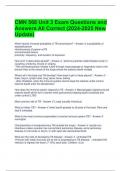CMN 568 Unit 3 Exam Questions and
Answers All Correct (2024-2025 New
Update)
Which factors increase probability of TB transmission? - Answer ✔ susceptibility of
exposed person
infectiousness of person w/TB
environmental factors
proximity, frequency, and duration of exposure
How is M. Tuberculosis spread? - Answer ✔ -airborne particles called droplet nuclei r/t
coughing, sneezing, shouts or singing.
-The uninfected person inhales nuclei through nasal passage or respiratory tract to the
bronchi then to the alveoli of the lungs where the tubercle bacilli multiply
Where all in the body can TB develop? How does it get to these places? - Answer ✔ -
brain, larynx, lymph node, lung, spine, bone, kidney
- after inhalation, when the immune system cannot keep the tubercle under control,
tubercle bacilli enter the bloodstream
How does the immune system respond to TB - Answer ✔ Macrophages ingest/surround
tubercle bacilli which form a barrier shell (granuloma) keeping bacilli contained and
under control (LTBI)
Most common site of TB - Answer ✔ Lungs (usually infectious)
What is miliary TB? - Answer ✔ when bacilli spreads to all parts of the body. Rare and
fatal if untreated.
What is the most common presentation of central nervous system TB? - Answer ✔
meningitis.
Characteristics of extrapulmonary TB (outside the lungs) - Answer ✔ usually non
infectious unless a person has concomitant pulmonary disease, extra-pulmonary
disease of oral cavity or larynx, or with open site (aerosolized fluid)
What are the risks of developing TB disease - Answer ✔ -Untreated TB
-Persons with weak immunity are at risk of progressing to TB disease. - untreated HIV
infection is highest risk factor (7-10%) each year. Children <5 yo
,What is drug resistant TB due to? - Answer ✔ organisms resistant to one or more TB
drugs.
What is multi-drug resistant TB (MDR) - Answer ✔ caused by bacteria resistant to best
TB drugs- isoniazid and rifampin
What is Extensively Drug-resistant TB (XDR) - Answer ✔ caused by organisms resistant
to isoniazid and rifampin, plus flouroquinolones and >1 of the 3 injectable second-line
drugs.
How and when can latent TB infection (LTBI) be detected. - Answer ✔ 2-8 weeks after
infection
by TST or interferon-gamma release assay (IGRA)
What is the progression of TB disease? - Answer ✔ granulomas break down, bacilli
escape, multiply = tb disease.
When can TB disease occur - Answer ✔ soon after infection or years later
How is TB disease diagnosed? - Answer ✔ Positive M. tb culture
Patient has small amount of TB bacteria in body that are alive but inactive, cannot
spread TB to others, does not feel sick, and does not require isolation. What should the
FNP suspect? - Answer ✔ Latent TB infection. (Infected, not infectious)
Patient has large amount of active TB in body, may spread TB to others, symptoms
involve cough, fever, weight loss, CXR may be abnormal, sputum smears positive,
needs treatment. What should the FNP suspect - Answer ✔ TB disease (infectious)
Methods for detecting M. tuberculosis infection in the US - Answer ✔ Mantoux
tuberculin skin test (TST)
IGAs- Quantiferon-TB gold in tube (QFT-GIT) and
T-spot TB
How long does the body take to react to PPD (from a Mantoux Tuberculin Skin Test) -
Answer ✔ 2-8 wks after exposure and infection for the immune system to react to PPD
Should a Mantoux Tuberculin skin test be given to pregnant women? - Answer ✔ yes.
Patient has a ≥ 5 mm induration TST reaction, what pt will this be considered positive
in? - Answer ✔ Those with HIV
Recent contact of infectious TB
person w/fibrotic change on CXR consistent w/prior TB
, Pt. w/organ transplants and other immunosuppressed pt.
Pt has a ≥ 10 mm induration TST reaction , what type of pt will this be considered
positive in? - Answer ✔ Recent arrival from high-prevalence countries
Injection drug users.
Residents/employees of high-risk congregate setting
Mycobacteriology laboratory personnel
pt. w/conditions that increase risk for progressing to TB
Child <5 yo, or children and youth exposed to adults high risk
≥ 15 mm induration TST reaction, what type of pt is this considered + in? - Answer ✔
persons with no known risk factors.
Which persons should receive a BCB Vaccination - Answer ✔ Health-care workers who
work in settings w/high % of MDR TB, transmission of drug-resistant TB strains &
subsequent infections are likely, and comprehensive TB infection-control precautions
implemented but not successful.
History to obtain when evaluating pt. for TB - Answer ✔ symptoms of disease (how
long),
hx of TB exposure, infection, disease
past TB treatment
demographic RF for TB
Medical conditions that increase risk of TB (HIV, child <5)
Symptoms of pulmonary TB - Answer ✔ prolonged cough for 3 wks or longer,
hemoptysis, CP, loss of appetite, unexplained wt. loss, night sweats, fever, fatigue
symptoms of possible extra-pulmonary TB - Answer ✔ blood in urine (TB kidney)
Headache/confusion (TB meningitis)
Back pain (TB spine)
Hoarseness (TB larynx)
loss of appetite, unexplained wt. loss night sweats, fever, fatigue
Can a physical exam confirm or rule out TB disease - Answer ✔ No
Which tests help to differentiate persons with m. TB infection from those not infected? -
Answer ✔ TST, IGRAs
Does a CXR confirm TB? - Answer ✔ No. Can suggest
What CXR view is standard for TB - Answer ✔ posterior-anterior view
What is the gold standard for diagnosing TB - Answer ✔ sputum culture




